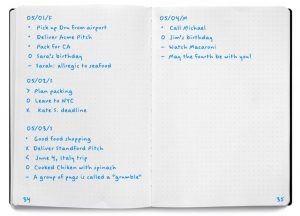Leo Mirani in 1843 Magazine:
 So it is with organising my life. I have tried paper diaries, Google Calendar and to-do apps. No matter the form, what they all have in common is a rigid structure imposed from above. You have a certain number of lines for each day or a finite number of categories into which your plans must fit, or a small palette of colours to highlight or distinguish between events. It drives me insane. So I made my own system: a Google spreadsheet with columns titled “today”, “tomorrow”, “this week”, “weekend”, “this month” and “three months”, and tabs to keep track of expenses, books I’ve read, travel plans, story ideas, and general note-keeping. It’s messy and entirely manual: there are no shortcuts, no functions, no add-ons.
So it is with organising my life. I have tried paper diaries, Google Calendar and to-do apps. No matter the form, what they all have in common is a rigid structure imposed from above. You have a certain number of lines for each day or a finite number of categories into which your plans must fit, or a small palette of colours to highlight or distinguish between events. It drives me insane. So I made my own system: a Google spreadsheet with columns titled “today”, “tomorrow”, “this week”, “weekend”, “this month” and “three months”, and tabs to keep track of expenses, books I’ve read, travel plans, story ideas, and general note-keeping. It’s messy and entirely manual: there are no shortcuts, no functions, no add-ons.
Which brings me to the Bullet Journal. When my colleagues at 1843 suggested I try this so-called “analogue system for the digital age”, I was sceptical. This “system” was developed by a designer in Brooklyn called Ryder Carroll, and has sparked a thriving sub-culture of “bullet journalists”. There are blogs dedicated to the art. The Instagram hashtag #bulletjournal has 2.2m pictures, many of beautiful, arty journals. The hashtag #bujo has another 1.7m. It appeared to be some sort of cult of productivity.
More here.
